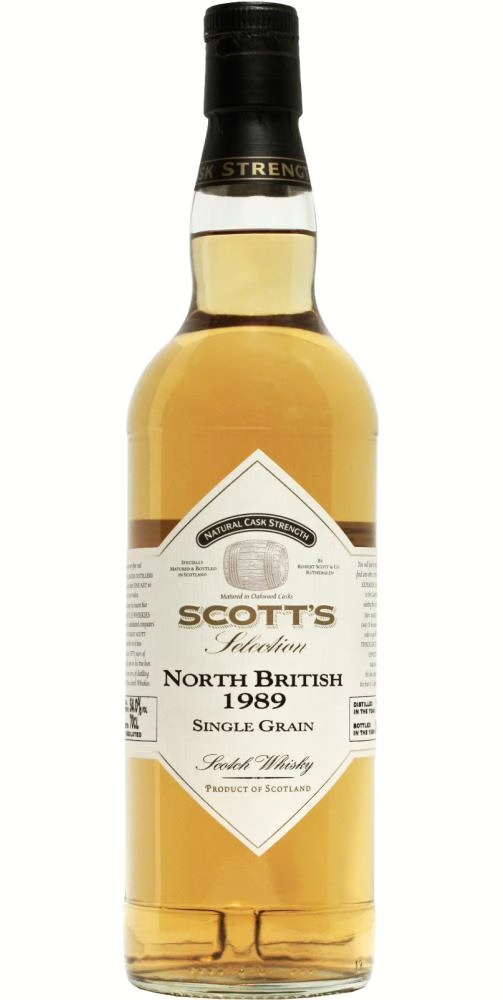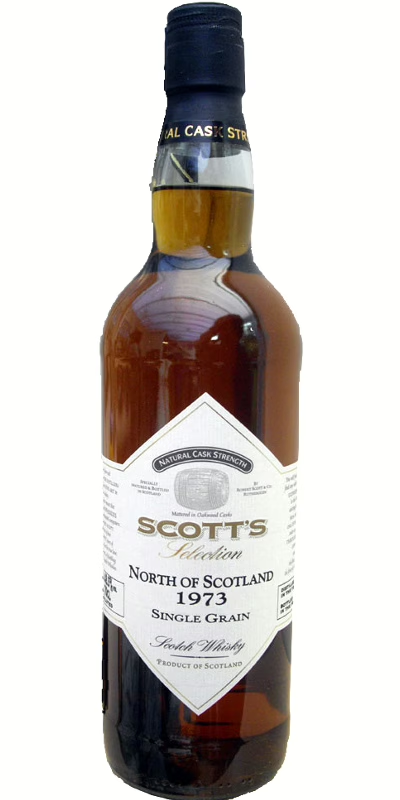Today, we’ll explore two single grain whiskies that share a common thread: their names both start with “North.” One has an intriguing history and is still in operation, while the other has a complex, double-layered past that has come to an end. If you’re feeling a bit confused, don’t worry—I intentionally made it sound complicated. So, take a seat, pour yourself a dram, and let’s break it down together. Once we’ve cleared things up, we’ll dive into tasting and reviewing two single casks: a North British 1989 and a North of Scotland 1973, both bottled by Scott’s Selection.
North British Distillery
The North British Distillery, established in 1885, holds a significant place in the history of Scotch whisky production. Located in the Gorgie area of Edinburgh, Scotland, the distillery was founded by a group of independent distillers, including Andrew Usher, William Sanderson, John M. Crabbie, and James Watson, who sought to challenge the monopoly held by the Distillers Company Ltd. (DCL) over the supply of grain whisky.
The distillery began production in 1887 and quickly became a major player in the industry. Within its first year, it was producing 3,600,000 litres of spirit annually. By the start of World War I, production had increased to 9,000,000 litres per year, but operations were halted in 1917 due to a shortage of grain.
During World War I, the distillery was repurposed for munitions production, specifically to make acetone, a key component in the manufacture of cordite, an explosive used in place of gunpowder. This effort was part of the broader war contribution, and a telegram from Prime Minister Lloyd George in February 1916 highlighted the distillery’s role in these wartime activities.
The distillery faced another closure during World War II, shutting down in December 1939 due to a lack of raw materials. It did not resume operations until 1949. The post-war period saw a gradual recovery, and by 1955, production levels had fully rebounded. In 1961, the distillery’s annual output had expanded to 13 million litres of alcohol, necessitating further investments in warehousing.
In 1993, the management of the North British Distillery Company (NBDC) was taken over by Lothian Distillers, a joint venture between Robertson & Baxter (now Edrington) and International Distillers & Vintners (IDV). This partnership bought out all other shareholders and continued to operate the distillery under the North British name.
Today, the North British Distillery is one of the largest grain whisky producers in Scotland, and its products are key components in many well-known blended Scotch whiskies.
North of Scotland Distillery
The name ‘North of Scotland’ did not appear initially at the distillery that produced the grain whisky I’ll review below, but at the Bon Accord Distillery:
Bon Accord Distillery
The Bon Accord Distillery, located in Aberdeen, Scotland, has a rich history that is intertwined with the broader narrative of Scotch whisky production. The distillery was established in 1855 by the Bon Accord Distillery Company, utilising the stills and vessels from the failed Union Glen Distillery, which had ceased operations in 1853. The site of the Bon Accord Distillery was originally a brewery that had been producing beer since 1785, highlighting the deep-rooted industrial heritage of the area.
The name ‘Bon Accord’ is derived from the Scottish phrase meaning ‘good agreement’, reflecting the unity and cooperation among the Scots, particularly in the context of distinguishing themselves from the English. The distillery was known for its significant production capacity, capable of producing over 300,000 gallons of whisky annually, which ranked it as one of the largest Highland malt distilleries in Scotland. The whisky produced at Bon Accord was primarily sold under the brand ‘Cock-o’-the-North,’ which was well known and exported internationally.
In 1896, the Bon Accord Distillery Company Ltd. ceased trading, and the distillery and its assets were acquired by Dailuaine-Talisker Distilleries Ltd. The new owners renamed the distillery ‘North of Scotland,’ marking a significant change in its identity. The distillery continued to operate under this new name until its closure in 1910.
The North of Scotland name was later acquired by distiller and blender George Christie, who applied it to his column still grain distillery near Alloa.
North of Scotland/Strathmore Distillery
The North of Scotland Distillery, also known as Strathmore, was a significant player in the Scotch whisky industry during the mid-20th century. Located in the Lowland region of Scotland, specifically in Cambus, Clackmannanshire, the distillery was founded by George Christie in 1958. It was established within the converted buildings of the former Robert Knox’s Forth Brewery, which dated back to 1786.
The North of Scotland Distillery was unique in that it housed both grain and malt whisky production facilities under one roof. The grain whisky operation was known as North of Scotland, while the malt whisky distillery was called Strathmore. The distillery was equipped with three patent stills for grain whisky production and two copper pot stills for malt whisky production. This dual setup allowed the distillery to produce both types of whisky simultaneously, catering to the high demand for blended Scotch whiskies.
The malt whisky produced at Strathmore was primarily sold to blenders, with very few bottles of Strathmore single malt remaining in existence. The malt whisky operation was short-lived, as the demand for grain whisky far outstripped that for malt whisky. By 1959, the pot stills were removed to make way for a larger mash tun, increasing the grain output of the North of Scotland Distillery. This shift in focus was driven by the high demand for grain whisky, which was a crucial component in blended Scotch whiskies.
Despite its initial success, the North of Scotland Distillery faced challenges due to overproduction in the industry during the 1980s. This led to the closure of the distillery in 1980, and the site was subsequently sold to the Distillers Company Limited (DCL) in 1982. The remaining buildings were used as warehouses for the nearby Cambus distillery until they were eventually demolished in 1993.
North British 1989 Scott’s Selection (2011) Review
The first single grain single cask we’ll explore was distilled at the North British Distillery in 1989 and bottled in 2011 by Scott’s Selection, after ageing for 22 years. While I don’t have many specific details about this bottling, I can tell you that it was released at cask strength, with an ABV of 54%.

Colour:
Old gold.
Nose:
Neat: The nose has a low intensity. It does feel grainy, but not overly so. Sweet popcorn with a bit of caramel, vanilla and honey. Grain whisky usually takes a lot of influence from the cask, as it’s a lighter spirit, and it shows here.
With water: More pronounced vanilla aromas emerge, along with hints of coconut shavings.
Palate:
Neat: The palate is sweet and spicy, with a peppery heat that builds briefly. Flavours of salted caramel popcorn, vanilla, and a slight bitterness reminiscent of spent black tea leaves, with a silky mouthfeel.
With water: The profile remains similar, but with added notes of lemon and orange juice.
Finish:
The finish is long, with lingering sweetness from the popcorn and vanilla, complemented by a light, chocolatey bitterness.
Comments:
This grain is quite simple yet enjoyable. Unlike some other grain whiskies, it doesn’t cause the sickening effect I often experience, where a second or third dram can feel overly sweet and cloying.
Rating: 6/10
North of Scotland 1973 Scott’s Selection (2012) Review
Distilled in the North of Scotland in 1973, this whisky was aged 39 years in a bourbon barrel. It was bottled by Scott’s Selection in 2012 at its natural cask strength of 48.5%, without chill filtration and retaining its natural colour.

Colour:
Brownish tawny. Like a whisky with a hefty dose of E150, except here this is its natural colour.
Nose:
Neat: The aroma is light and inviting, featuring notes of brown sugar, pecan pie, caramel, and vanilla. Subtle hints of coconut and toasted oak are present, without an overly grainy character.
Palate:
Neat: The initial taste is marked by butterscotch, followed by flavours reminiscent of tarte tatin and pain aux raisins, minus the overly sweet glaze. Citrus notes of lemon and pink grapefruit add a refreshing balance.
Finish:
A breakfast-inspired finish featuring pepper, orange, pain aux raisins, and coffee, lingering pleasantly.
Comments:
This North of Scotland 1973 from Scott’s Selection is a delightful old single grain whisky. It occasionally evokes the character of a middle-aged bourbon, making it an unexpected yet enjoyable reinterpretation of a French breakfast.